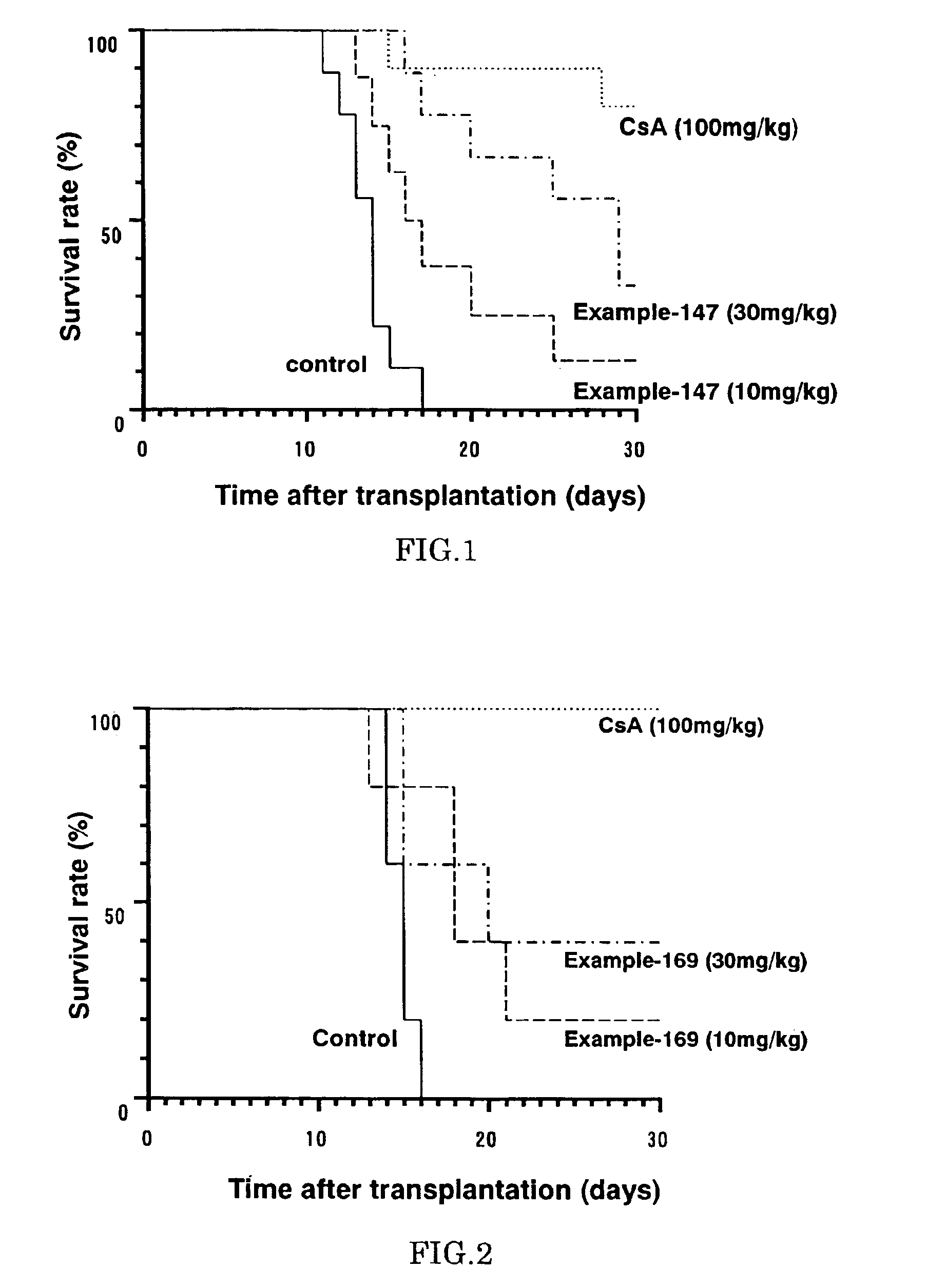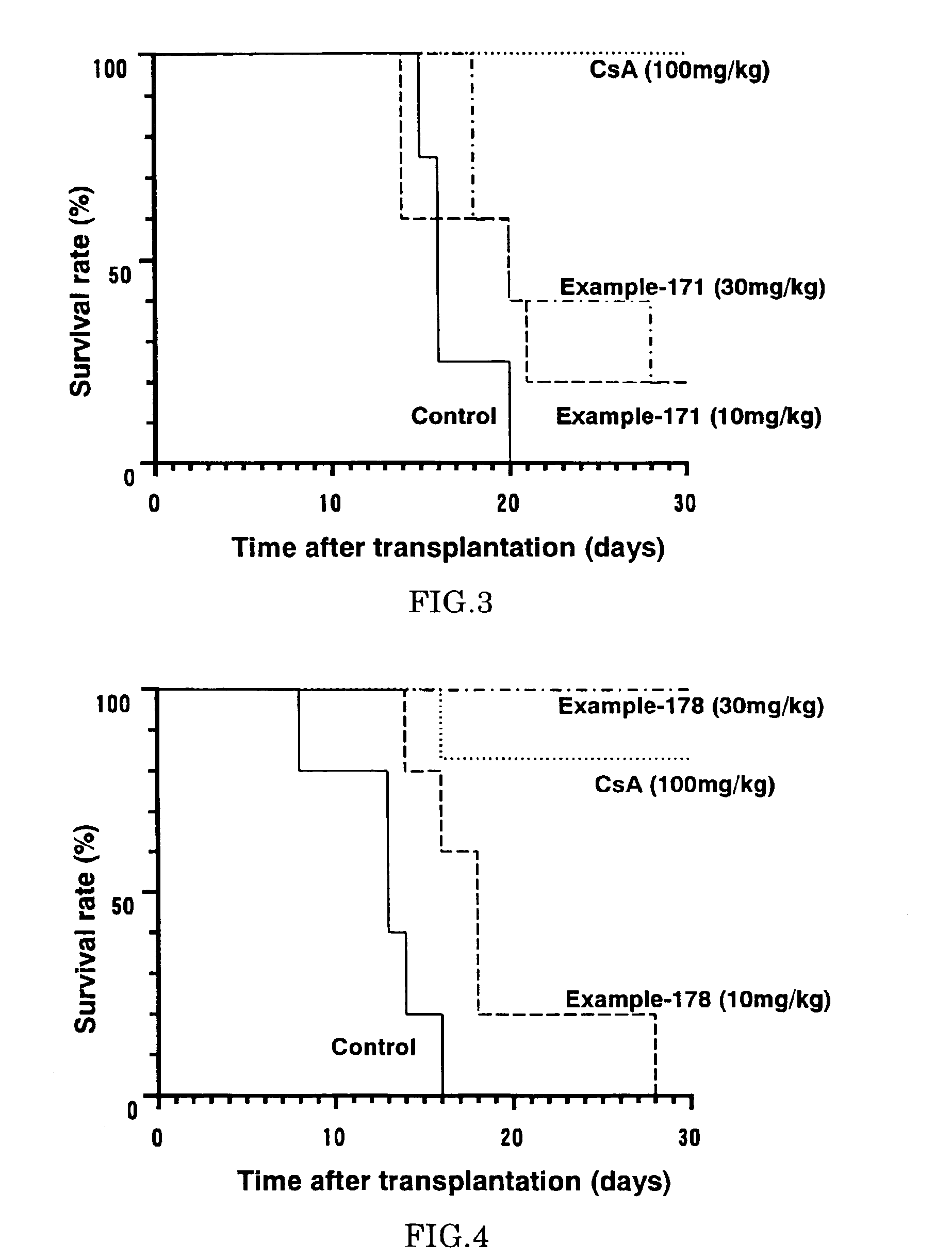Diaryl ether derivative, addition salt thereof, and immunosuppressant
a technology of diaryl ether and derivatives, applied in the field of diaryl ether derivatives, salts and hydrates thereof, can solve the problems of insufficient effectiveness, no conventional immunosuppressive agents are satisfactory in view of efficacy and potential side effects, and achieve the effect of significant immunosuppressive effects and little side effects
- Summary
- Abstract
- Description
- Claims
- Application Information
AI Technical Summary
Benefits of technology
Problems solved by technology
Method used
Image
Examples
reference example 1
[0052]4-(3-benzyloxyphenoxy)-2-chlorobenzaldehyde
[0053]Potassium carbonate (5.53 g) was added to a DMF solution (70 ml) of 2-chloro-4-fluorobenzaldehyde (3.35 g) and 3-benzyloxyphenol (4.23 g) and the solution was stirred for 3 hours while heated to 150° C. The reaction mixture was decanted into water and was extracted with ethyl acetate. The organic phase was sequentially washed with water and a saturated aqueous solution of sodium chloride and was dried with anhydrous sodium sulfate. The solvent was removed by distillation under reduced pressure and the residue was purified by silica gel column chromatography (hexane:ethyl acetate=6:1). In this manner, the desired product (6.73 g) was obtained as a colorless powder.
reference examples 2 through 37
[0054]Using various phenol derivatives and aldehydes, compounds shown Table 1 were synthesized in the same manner as in Reference Example 1 above.
[0055]
TABLE 1ReferenceExampleR1R2R3R42CF3HHH3CF3HMeOH4CF3HHMeO5CF3HClH6CF3HHCl7CF3HHPhCH2O8CF3HCF3H9CF3HHCF310CF3CF3HCl11CF3Ph(CH2)2HH12Ph(CH2)2Ph(CH2)2HH13Ph(CH2)2HHCl14Ph(CH2)2HHCF315Ph(CH2)2Ph(CH2)2HCl16Ph(CH2)2Ph(CH2)2HCF317PhCH2OHHH18PhCH2OPhCH2OHH19PhCH2OHHi-Pr20PhCH2OPhCH2OHCl21PhCH2OClHCl22PhCH2OHHBr23PhCH2OHHCF324PhCH2OHHPh25MeOCF3HH26MeOCF3HCl27t-BuHHH28MeSHHH29n-C5H11HHH30n-C7H15HHH31i-Pri-PrOHH32i-Pri-PrOHCl33i-Pri-PrHCl34ClClHCl35PhCH2SHHH36PhCH2SHHCl37MeHHH
reference example 38
[0056]2-fluoro-4-[(3-trifluoromethyl)phenoxy]benzaldehyde
[0057]3-(trifluoromethyl)phenylboric acid (1.03 g) and 2-fluoro-4-hydroxybenzaldehyde (760 mg) were dissolved in methylene chloride. While the solution was stirred, copper acetate (985 mg), molecular sieve 4A (800 mg), and triethylamine (3.76 mL) were added. After 6 and 24 hours, the same amount of copper acetate was added and the mixture was stirred for additional 48 hours. The insoluble material was then filtered out and the filtrate was decanted into water and was extracted with ethyl acetate. The organic phase was washed with water and then with a saturated aqueous solution of sodium chloride and was dried with anhydrous magnesium sulfate. Subsequently, the solvent was removed by distillation under reduced pressure and the residue was purified by silica gel column chromatography (hexane:ethyl acetate=7:1, and then 2:1). In this manner, the desired product (265 mg) was obtained as a yellow oil.
PUM
| Property | Measurement | Unit |
|---|---|---|
| temperature | aaaaa | aaaaa |
| temperature | aaaaa | aaaaa |
| temperature | aaaaa | aaaaa |
Abstract
Description
Claims
Application Information
 Login to View More
Login to View More - R&D
- Intellectual Property
- Life Sciences
- Materials
- Tech Scout
- Unparalleled Data Quality
- Higher Quality Content
- 60% Fewer Hallucinations
Browse by: Latest US Patents, China's latest patents, Technical Efficacy Thesaurus, Application Domain, Technology Topic, Popular Technical Reports.
© 2025 PatSnap. All rights reserved.Legal|Privacy policy|Modern Slavery Act Transparency Statement|Sitemap|About US| Contact US: help@patsnap.com



